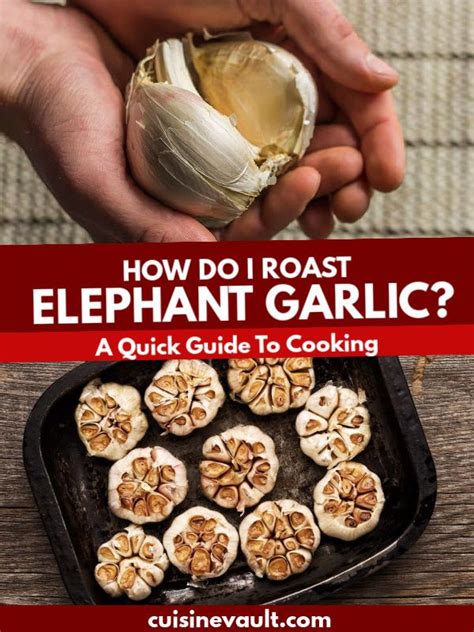How Do You Cook Elephant Garlic
Ronan Farrow
Mar 20, 2025 · 3 min read

Table of Contents
How to Cook Elephant Garlic: A Comprehensive Guide
Elephant garlic, with its massive cloves and mild flavor, is a culinary delight. While it resembles garlic, its taste is sweeter and less pungent, making it a versatile ingredient for various dishes. This comprehensive guide will walk you through different methods of cooking elephant garlic, from roasting to pickling, ensuring you get the most out of this unique bulb.
Understanding Elephant Garlic
Before diving into cooking methods, let's clarify the distinction between elephant garlic and regular garlic. Elephant garlic is a close relative, botanically classified as a different species (Allium ampeloprasum), not a true garlic (Allium sativum). This difference explains its larger size and milder flavor profile. Its milder flavor makes it a great choice for those who find regular garlic too strong.
Preparing Elephant Garlic for Cooking
Regardless of your chosen cooking method, proper preparation is key. Here’s how to prepare your elephant garlic:
Cleaning and Separating the Cloves
- Remove the outer papery layers: Gently peel away the dry, outer layers of the bulb until you reveal the inner cloves.
- Separate the cloves: Elephant garlic cloves are significantly larger than regular garlic cloves and often come apart easily. Gently separate them. If any stubborn cloves remain attached, use a sharp knife to carefully pry them apart.
- Optional: Peel the cloves: For some recipes, like roasting, you can leave the papery skin on the cloves. However, for other applications like adding to sauces or purees, peeling the cloves is recommended. You can easily peel them by gently squeezing each clove; the papery skin should slip off easily.
Cooking Methods for Elephant Garlic
Now, let's explore various cooking techniques to highlight the unique flavor of elephant garlic:
Roasting Elephant Garlic
Roasting intensifies the sweetness of elephant garlic and creates a wonderfully soft and caramelized texture. This method is perfect for adding to dips, spreads, or as a flavorful topping.
Instructions:
- Preheat your oven to 400°F (200°C).
- Cut off the top of the elephant garlic bulb, exposing the cloves. You don't need to separate the cloves.
- Drizzle with olive oil, salt, and pepper (or your favorite herbs).
- Wrap the whole bulb in foil and roast for 45-60 minutes, or until the cloves are very soft.
Sautéing Elephant Garlic
Sautéing elephant garlic is a quick and easy method that adds a subtle garlic flavor to your dishes.
Instructions:
- Slice or mince the peeled elephant garlic cloves.
- Heat olive oil or butter in a pan over medium heat.
- Add the elephant garlic and sauté for 2-3 minutes, or until softened and lightly golden.
Pickling Elephant Garlic
Pickling creates a tangy and flavorful condiment. Pickled elephant garlic adds a unique zest to salads, sandwiches, and other dishes.
Instructions:
- Prepare a brine solution with water, vinegar, salt, and sugar.
- Pack peeled and sliced elephant garlic cloves into a clean jar.
- Pour the brine over the garlic, ensuring all cloves are submerged.
- Seal and store in the refrigerator for at least a week to allow the flavors to meld.
Adding Elephant Garlic to Other Dishes
Elephant garlic’s milder flavor makes it a versatile addition to many dishes:
- Soups and stews: Adds depth and richness.
- Pasta sauces: Offers a subtle garlic flavor without overpowering other ingredients.
- Salads and dressings: Provides a sweet and savory element.
- Mashed potatoes: Elevates the flavor profile.
Tips for Success
- Storage: Store whole unpeeled elephant garlic heads in a cool, dark, and dry place. Peeled cloves should be stored in the refrigerator in an airtight container.
- Substitution: While elephant garlic is unique, you can substitute it with regular garlic in most recipes. However, bear in mind that the flavor profile will be stronger and more pungent.
- Experimentation: Don't be afraid to experiment with different cooking methods and flavor combinations to discover your favorite ways to use elephant garlic.
By following these steps, you'll master the art of cooking elephant garlic and elevate your culinary creations with its unique flavor. Remember to adjust cooking times based on your preferred level of softness and caramelization. Happy cooking!
Featured Posts
Also read the following articles
| Article Title | Date |
|---|---|
| Kate Hudson Dress How To Lose A Guy | Mar 20, 2025 |
| How To Wire A Relay For A Horn | Mar 20, 2025 |
| Pet Lift Face Lasts How Long | Mar 20, 2025 |
| 5000 In 1977 Is Worth How Much Today | Mar 20, 2025 |
| How Deep Is The White River In Indianapolis | Mar 20, 2025 |
Latest Posts
Thank you for visiting our website which covers about How Do You Cook Elephant Garlic . We hope the information provided has been useful to you. Feel free to contact us if you have any questions or need further assistance. See you next time and don't miss to bookmark.
